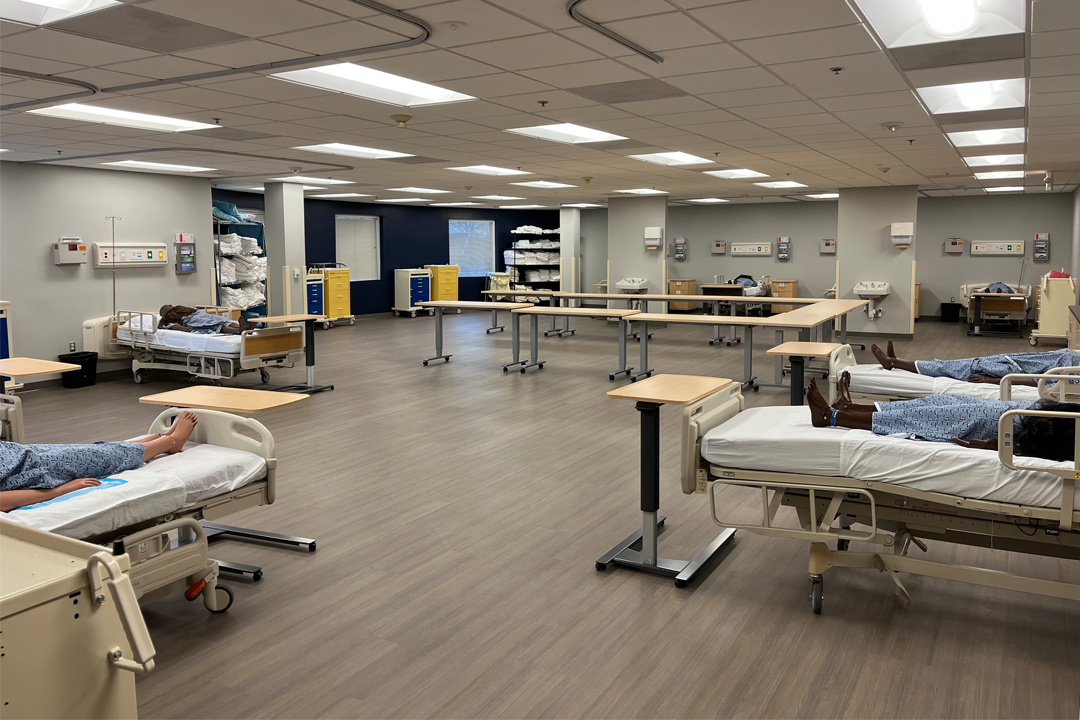The Johnson Lab reopened this semester following renovations that enable more flexible learning and dynamic usage of the skills lab space.
The Johnson Lab, named after the school’s founding Dean Jean Johnson, opened in October 2015. The space was billed as a virtual hospital with patient beds populated by static and mid-fidelity mannequins that simulate patients from infants to the elderly—preparing student nurses with the skills needed to provide effective clinical care. The lab space is primarily used by Accelerated B.S.N. students and their instructors.
The $500,000 project was completed before the start of the spring 2022 semester. Crystel Farina, director of simulation and experiential learning and clinical education instructor, said the renovations give faculty greater flexibility in skills lab instruction.
“It really makes it so we can do a lot more in there,” she said. “Now they can do all the learning in one space, and they can do it together as a group. The feedback from faculty has been overwhelmingly positive, it makes it much easier for them to communicate with the students.”
The renovations added 2,500 of usable square space to the skills lab, nearly doubling the amount of functional space. The renovation included the removal of a center wall, allowing students to learn alongside a greater number of their classmates, supporting greater collaboration and communication between students and faculty. Previously students rotated in small groups through the lab and into conference rooms as needed. A lecture space to support group learning was also added to the Johnson Lab.
The renovation opened the lab space to make room for linen carts and other equipment needed to accurately simulate a hospital setting, building muscle memory that will be critical to their future success, said Mary Doyle, an adjunct faculty clinical/skills lab instructor.
“We have some students with medical backgrounds, but other students have never set foot into a hospital before,” she said. “The purpose of the lab is to help build those foundations, help build some of those skills in order to prepare them so they're not shell-shocked when they walk into the hospital, they have some familiarity with things that they're seeing.”
Doyle teaches foundations of professional nursing for first semester students where they learn basic skills and practice building connections at the bedside. In the Johnson Lab, students practice skills in pairs and demonstrate competency using professional practice standards. With the lab mimicking the setup of a nursing unit, they learn how to work in teams to provide the best possible care.
“The students are not only learning the skills, but we're trying to piece together the communication piece with that patient safety piece,” Doyle said. “They’re learning, how do I explain this catheter to a patient? In layman's terms, how do I talk to the patient and communicate everything that I'm doing?”
A lecture space with easily moved tables and chairs was added to the space. This new area enables students to gather for PowerPoint presentations, instructional videos and to review plans for the day. Two additional scrub sinks were also added to the lab, giving students the opportunity to practice hand hygiene required in clinical settings.
Doyle uses the lecture space to discuss topics like medicine administration and safety around medication, where she’s able to engage with students before moving into the bed space. The change in layout gives instructors a clear view of the lab and enhanced ability to watch students practice skills and provide feedback in real time.
The feedback from students has been positive, Doyle said. Students enjoy being able to bounce ideas off one another and collaborate to solve problems the way they would in a clinical setting.
“Performing a task in pairs is a little less intimidating when you're still learning,” she said.
The Johnson Lab was rarely used during the early months of the COVID-19 pandemic, as space constraints required students to be closer together than recommended.
This renovation brings the school’s fully renovated simulation space to about 20,000 square feet. This includes the 2018 opening of the cutting-edge Simulation and Innovation Learning Center on the third floor of Innovation Hall.


